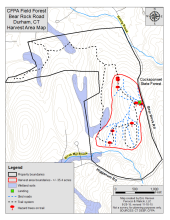Secondary tabs
Submission information
Howard B. Field Forest

The landowner is interested in maintaining forest health and tree species diversity, while simultaneously not disturbing existing recreational trails and limiting impacts to aesthetics. A mix of treatments were applied, including single tree selection, group selection, and thinning to move and enhance vigor of remaining trees, and to promote regeneration of native species of trees and other vegetation. Trees impacted by emerald ash borer (EAB) and spongy moth, as well as some dead trees near trails, were cut to maintain safety. The remaining trees and regeneration have responded very well to treatments.
Site Location
Durham, Connecticut
Bear Rock Road (east-central part of Durham, CT)
-72.657
41.472
From Route 17 in Durham, head east on Higganum Road. 1.3 miles after the stop sign, turn left to head north on Bear Rock Road. A small parking area/pulloff is on the east side of Bear Rock Road in +/- 0.3 miles.
Foot, ATV, and equestrian. Vehicles can park at the northern corner of the Coginchaug Regional High School parking lot and along Bear Rock Road.
Connecticut Forest and Park Association
+1 860-346-8733
Stand Information
120 acres
Central hardwoods
Rich Mesic Forest
Mid-successional forest based on tree species and volume.
emerald ash borer
,
,
emerald ash borer
gypsy moth
brandford silt loam, ellington silt loam, Ludlow silt loam, Manchester gravelly sandy loam, pootatuck fine sandy loam, Walpole sandy loam, Wethersfield loam, Wilbraham and Menlo soils, Wilbraham silt loam
1928
Land was previously used for agriculture but was abandoned prior to Field family ownership.
Pre-treatment Conditions
The land was farmed before 1928 when the Field family came into possession of the land. The Field family allowed forest to grow on the land, which grew mainly from succession via natural selection, with the occasional significant weather damage. The last known timber harvest was done in 1958. Because of this, the forest grew densely, resulting in high basal area and a high wood volume accumulation.
Quercus velutina (black oak)
36%
Fraxinus americana (white ash)
21%
Liriodendron tuliperfia (yellow-poplar)
10%
Basal area of 145 ft^2/acre
Invasive plants, Nectria in black birch, and some decline in black oak.
Silviculture Prescription
The Howard B. Field Forest is owned by the Connecticut Forest and Park Association (CFPA), a non-profit organization that since its inception in 1895 has been a voice for forests and their responsible stewardship. The Field Forest in Durham was donated by the Field family (particularly Howard Brigham Field). CFPA has owned this property since 2001. There was a forest stewardship plan update that was done in 2014 to help guide the management of the property. A light crown thinning was scheduled for 2015-2017 in two stages in different parts of the property. The first stage was conducted in 2016-2017 with a follow-up removal of some oak that had been killed by spongy moth in 2017-2018.
The owners were interested in maintaining tree vigor, retaining high quality individuals of a variety of species, reducing invasive plant populations and increasing regeneration.
Recreation, aesthetics, wildlife habitat, forest health, and education.
650 sawtimber trees were purchased, along with 366 firewood trees and the firewood portions of 69 cull trees. All trees were marked with one or more stripes, dots, or Xs with orange paint on the stem and stump. All 14 trees marked with a G should be girdled and left standing. Tops and portions of trees not suitable for sawtimber/firewood are to remain on the seller's property. Stand 1 was prescribed a light crown thinning to reduce crown density, increase residual stand vigor, and adjust species composition. 20-30% of current basal area was prescribed to be removed.
The long-term goal of stand 1 is an unfragmented, fully stocked, uneven-aged, mixed-hardwood forest that vigorously grows and improves in vertical structure. Species composition will remain unchanged in the short-term (with the exception of ash due to EAB), and invasive plants will need to be under control before timber management occurs.
By enhancing species composition, age and size class diversity, and age and size class structural complexity, the forest may become more resilient to future disturbances (ice/wind storms, drought, insects, disease, deer herbivory, and other climate change-induced conditions).
Hand felling and harvester with forwarder.
A team of a father and son used a mechanized harvester and hand felling with a forwarder to cut and move the trees to the landing. Additional volume was marked during the operation, of mostly ash, because EAB was found to be present here after initial marking occurred.
Post-treatment
yes
Post-Treatment Assessment may occur during the management plan update in 2025.
Miscellaneous
After the initial treatment was completed, there was a defoliation by spongy moth resulting in the mortality of many of the residual oak trees (especially black and white oak). A second harvest was done in fall of 2018 to salvage dead trees near trails. Where dead trees were not a safety hazard, they were retained for structure and wildlife purposes.
Statistics
136
feet squared per acre
Contact Information
Eric Hammerling
Executive Director
CFPA
Rockfall, Connecticut. 06481
United States
The Connecticut Forest & Park Association (CFPA) is a 501c3 nonprofit organization dedicated to connecting people to the land in order to protect forests, parks, walking trails, and open spaces in Connecticut for future generations. With a Staff of experienced conservation professionals, and a Board of Directors who strongly support CFPA's mission and values, CFPA delivers programs on Blue-Blazed Hiking Trails, Environmental Education, Land Conservation, and Public Policy.